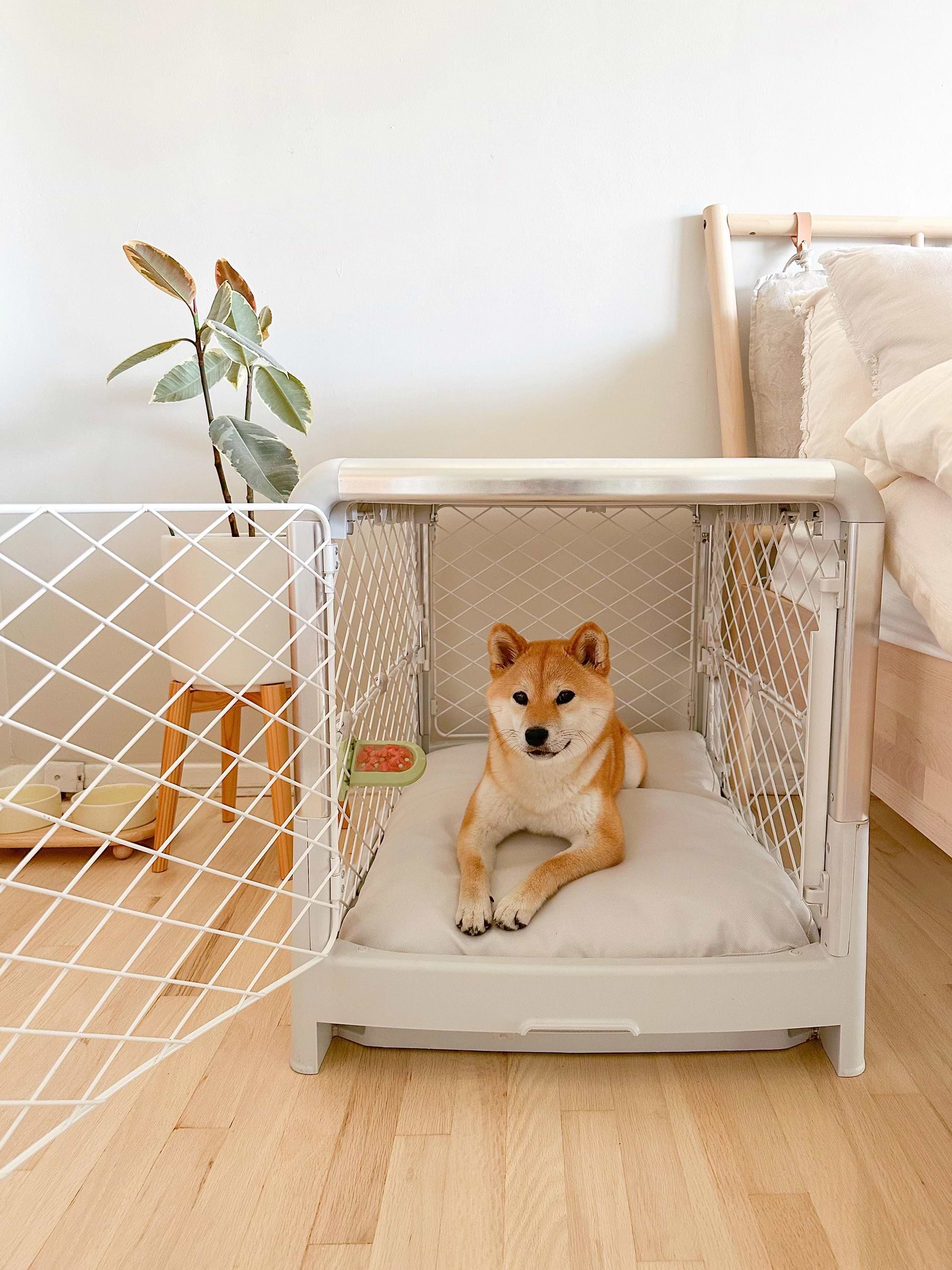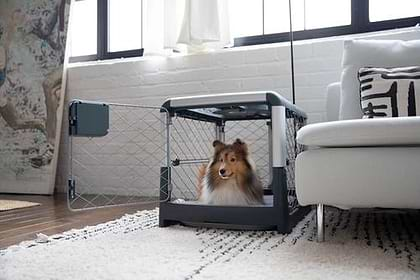What to Do When Your Dog Hates Their Crate
If your dog despises their crate, it's important to understand the reasons behind it. One common cause is dog crate anxiety, which can stem from past negative experiences or a lack of positive associations with the crate. To help your furry friend overcome this you can create a positive and inviting environment within the crate by placing familiar and comforting items, such as their favorite toys or cozy bedding. Additionally, implementing crate training techniques can gradually acclimate your dog to the crate and help them associate it with positive experiences.
Why Does My Dog Hate Their Crate So Much?
There can be several reasons why your dog hates their crate. Just a few of which include loneliness, discomfort due to improper sizing or bedding, and separation anxiety. At the core of the most common issues related to a dog not wanting to be in their crate however, is dog crate anxiety.
Dog crate anxiety
Dog crate anxiety is a common cause for dogs hating their crates. This type of anxiety can stem from things like previous negative experiences, lack of proper crate introduction or training, or a predisposition to anxiety or fearfulness.
When a dog has crate anxiety he or she may exhibit signs of distress, such as excessive whining, barking, pacing, drooling, or attempts to escape the crate. In our post Dog Crate Anxiety: 8 Ways To Reduce Anxiety, we shared a few things that may help such as finding a better crate, and using toys and calming aids such as our Groov Training Aid.
How Do You Help a Dog Who Hates the Crate?
If your dog hates their crate, below are a few ideas that may help them overcome their distaste for it and even develop a positive feeling about it.
- Gradual Introduction: Start by introducing the crate in a slow and positive manner. Leave the crate door open and place treats or toys inside to entice your dog to explore it voluntarily. Allow them to enter and exit the crate freely without any pressure.
- Positive Reinforcement: Use positive reinforcement techniques to associate the crate with positive experiences. Reward your dog with treats, praise, or a favorite toy when they willingly enter or spend time in the crate. Gradually increase the duration and frequency of crate time, always providing rewards and positive reinforcement.
- Create a Comfortable Space: Ensure that the crate is a comfortable and inviting space for your dog. Use soft bedding, blankets, or familiar items with your dog's scent to make it cozy and reassuring. Avoid overcrowding the crate and provide adequate ventilation.
- Gradual Closure: Once your dog is comfortable entering the crate willingly, start gradually closing the door for short periods while you are present. Initially, open the door immediately after closing it to prevent anxiety. Slowly increase the duration of door closure while monitoring your dog's comfort level.
We highly recommend the Revol Dog Crate for getting your pet comfortable with being in a crate because of its garage-style side door. When you open it, it creates a much more open space that can help dogs feel more comfortable when training.
- Avoid Punishment: Never use the crate as a form of punishment, as this can intensify your dog's negative association with it. The crate should be a safe and positive space for your dog, not a place of confinement or isolation.
- Seek Professional Help: If your dog's aversion to the crate persists or is accompanied by severe anxiety, consider consulting with a professional dog trainer or a veterinary behaviorist. They can provide personalized guidance and additional techniques to address your dog's specific needs.
What to put in a dog crate - make their experience more enjoyable
When helping a dog who hates their crate, it's essential to create a comfortable and inviting space inside the crate. Some items you may want to consider putting in the crate are comfy bedding, familiar items that have your dog's scent and/or your scent, and your dog's favorite treats or engaging toys. This can help create positive associations and provide mental stimulation while they are in the crate.
Crate Training
Crate training is an effective method to help a dog who hates their crate develop a positive association with it. Here are some key steps to follow during crate training:
Step 1. Introduce the crate gradually and positively, allowing your dog to explore it voluntarily. Start by leaving the crate door open and placing treats or toys inside to encourage your dog to enter.
Step 2. Use treats, praise, and rewards to reinforce positive behaviors associated with the crate. Reward your dog for entering the crate willingly and spending time inside.
Step 3. Increase the duration your dog spends in the crate over time. Begin with short periods and gradually extend the time while monitoring your dog's comfort level.
Step 4. Feed your dog their meals inside the crate to further associate it with positive experiences.
Be sure to check out the updated Diggs Bowl, now available in an option compatible with standard crates as well as Diggs crates, and the Revol Bowl Clip! You can easily snap it onto the diamond-shaped mesh. The best part? It helps prevent messes and spills, making it the perfect addition to your crate setup
Step 5. Once your dog is comfortable in the crate, begin closing the door for short periods while you are present. Gradually increase the duration of door closure, all the while ensuring your dog remains calm and comfortable.
Step 6. Practice leaving your dog alone in the crate for short periods, gradually increasing the duration. This helps them build confidence and trust that being in the crate does not mean isolation or abandonment.
Consistency, patience, and positive reinforcement are vital throughout the crate training process.
Commonly Asked Questions:
As we wrap up this post, let’s explore some of the most frequently asked questions we see about turning dog crate hate into crate love.
How do you help a dog who hates the crate?
Helping a dog who hates the crate involves gradual introduction, positive reinforcement, creating a comfortable environment, and implementing crate training techniques. Make the crate a positive and inviting space, use rewards and treats, and ensure a gradual acclimation process.
How do I stop dog crate anxiety?
To alleviate crate anxiety, create positive associations with the crate through gradual introduction, rewards, and a comfortable environment. Gradually increasing crate time and providing mental stimulation, can also help reduce anxiety. Additionally, considering techniques such as using calming pheromone sprays or seeking professional guidance may be beneficial for severe cases of crate anxiety.
How do I get my stubborn dog in a crate?
When dealing with a stubborn dog, it's that much more important to approach crate training with patience and positive reinforcement. Start by making the crate a positive space by placing treats or toys inside. Gradually encourage your dog to enter the crate voluntarily, using rewards and praise. Avoid using force or punishment though because this can increase resistance.
Why does my dog hate the crate so much?
It could be a lack of positive associations, feeling confined or isolated, discomfort, separation anxiety, or something else entirely.
Will my dog eventually stop crying in the crate?
Maybe. With proper training and acclimation, most dogs will eventually stop crying in the crate. However, the time it takes for a dog to adjust and stop crying can vary depending on their temperament, past experiences, and the training approach.
How long does it take to crate train?
The time it takes to crate train a dog can vary depending on things like the dog's age, temperament, and their past experiences. Some dogs may show progress within a few days, while others may require several weeks or even longer. Each dog progresses at their own pace, so it's important to focus on gradual and positive progress with patience and consistency rather than a strict timeline.
Your Dog Can Learn to Love Their Crate
By creating a comfortable and inviting space, gradually introducing the crate, and using rewards to establish positive associations, you can help your dog learn to love their crate. Looking for a crate that prioritizes your dog's comfort and enjoyment such as the Revol Dog Crate is also key. The Revol Dog Crate is designed to provide a safe and pleasant space for your furry friend. Click here to learn about the Revol Dog Crate.
If you’re like us, you love saving. It means more money for dog treats, after all. Check out our Complete Crate Set to save 15%. The crate set includes the Snooz Crate Pad, Diggs Bowl and Crate Clip, Groov Training Aid, and Treat Spread.
Already have your crate? You can also enjoy 15% off the Crate Training Set which includes the Groov Training Aid and two treat spreads!
Additional Resources That May Help:
You might also like
Crate training tips, stories and inspiration
View all blogsIn Your Diggs
Share your photos with #DiggsPet and tag us @DiggsPet on IG and TikTok.



